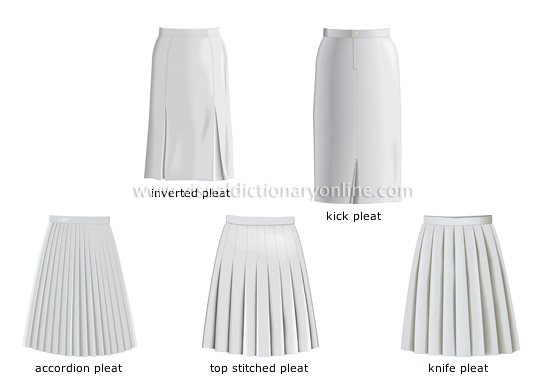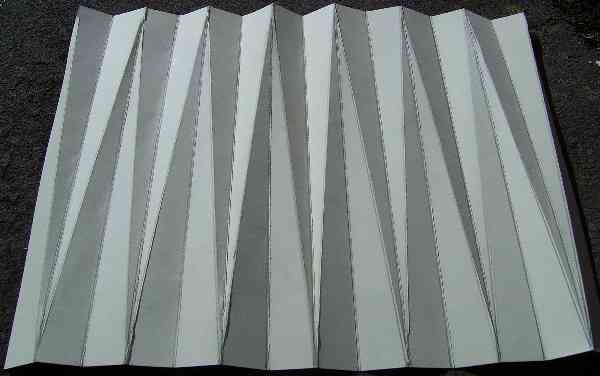Pleat
Pleated (French: folded ) is a flat textile with artificially formed wrinkles.
Woven Pleated
Pleated Woven is made of two chains and a weft yarn on weaving machines that are equipped with devices for tissue displacement or variable loading shock.
The basic chain is pulled tight, while the folding chain is only slightly slowed down. After Abweben of several weft threads are allowed to thwart the shot just the wrinkles chain backbone remains in the lower compartment and the whole fabric width is a fold ( a pleated ) formed.
The Plisseeffekt can be strengthened by the use of crepe yarns or yarns of different elasticity. The fabrics are produced in all basic weaves mainly as shirting and dress material.
Wirkplissee
Wirkplissee can be produced on a warp knitting machine with three guide bars. Two tracks operate continuously, but the third is only periodically mesh. During the stop time of the third guide bar buckles in addition to the floating threads a pleat (see picture right). In order to produce pleated, machines must be equipped with a so-called blind folding unit.
Strickplissee
At knitting machines with two knitting heads a pleated formed by bonding combination of right-right and right-left. From three to four stitches in right-left binding a vertical strip that twists after the change in law, the right bond and forms a permanent crease in the fabric is created. By a suitable needle distribution Stand folds, lying or hollow folds can occur.
A hand-knitted pleats (see picture right), make eg 18 stitches (the first folding side), one stitch off-hook ( break), 18 stitches (the second folding side), one stitch left ( inner rift between two folds ). The combination is completed and reviewed by edge stitches and decreases according to the shape of the knitted fabric.
Chemical- technical pleating
The pleating is a finish that consists of three operations: treatment with synthetic resin and other chemicals, folding and pressing Insert. The pressing of the meter occurs at participation of moist heat on Pleating, smaller products are processed manually.
Duration wrinkles only be guaranteed if garments made of synthetic fibers (in practice mainly of polyester). Wrinkles on fabrics made from natural fibers are not wash -resistant.
For the pleating of a so-called wool fabrics Siroset method is employed. A supposedly permanent pleating is achieved here with concentrates of Etanolaminsulfit include the 25 % sulfuric acid.
There are three basic types of folds distinguished: Liegeplisseefalten that are pressed in a direction Tollplisseefalten ( two-sided, against each other running Liegeplisseefalten ) and Stehplisseefalten that are straight, like an accordion running and standing wrinkles. This additional forms can be combined as Sonnenplissees in which radiating, runs around the Stehplisseefalten by the federal government are wider to the hem, or Bahnenplissee, a combination of narrow and wide Plisseearten.
Pleated fabrics are mainly used for clothing (skirts, sleeves ) and window blinds.










